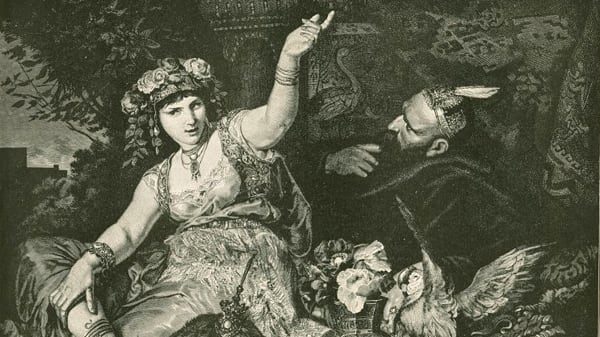Long before meta-fiction, blog fiction, expropriation, or hypertext, there was Shahrazad, the slinkiest, sexiest, most ineradicable trickster in global literature, telling stories every night toward the event horizon of 1001 nights to distract her abusive husband, the Sultan, from his resolve to behead each of his wives for infidelity—while her sister curled beside them on the divan, like a kinky teleprompter, or laugh-sigh-gasp track. The result, Tales of a Thousand and One Nights, or Arabian Nights, as it became known after its first English translation, in 1706, kicked off a craze of Orientalism that morphed across supposedly rational Enlightenment Europe in spoofs, follies, turqueries, pantomimes, and lots of camping it up in djellaba, or lounging on “ottomans.” Some of its signature tales—Aladdin’s lamp, Sinbad’s voyage, or Ali Baba’s thieves—were likely only smuggled into the text later by French translator Antoine Galland, spun by him from mere parentheses of plot in the 14th-century Syrian manuscript he was busily mining.
In Stranger Magic: Charmed States and the Arabian Nights, the British theorist of fairy tales and folktales, as well as of Joan of Arc and the Virgin Mary, Marina Warner, thinks her way through this elaborate frame-tale collection, and its significant aftershocks of response in the West, with lots of appropriate zigzags and dizzying detours of cultural free-association. Her book fits into a micro-genre that has been trending up recently, the book-about-a-book (think: Francine Prose’s Anne Frank: The Book, The Life, The Afterlife; Gary Wills Augustine’s Confessions: A Biography; Nathaniel Philbrick’s Why Read Moby Dick?) Like a preceding it micro-genre—the memoir—the book-about-a-book relies on personal voice, or what are now known as “reader-response” essays in colleges. The format fits especially well for trying to pick the locks of Arabian Nights, itself a collection of boxes within boxes of twice- or thrice-told tales.
Warner helpfully intersperses 15 paraphrased versions of the jump-the-shark stories Shahrazad interrupted each dawn so that her plot-driven husband would keep her alive to finish the next night, his moment of satisfaction infinitely receding: “The City of Brass,” “The Prince of the Black Islands.” She astonishes with the granularity of her accounts of the impact of these stories on their original European readers: inspired by the Arabian literature craze, as well as by the Persian poets Hafiz and Rumi, Goethe took to wearing a caftan and turban, known as “turning Turk” in the 18th century, while writing his West-Eastern Divan. Much of the narrative machinery of the original tales, such as Solomon’s flying carpet on which entire armies could be transported, both predicted and were then perfected in silent movies, especially the Hollywood “Easterns,” often prequels and sequels to Arabian Nights, beginning with Douglas Fairbanks’s lavish The Thief of Bagdad (1924), as well as musical theater and Walt Disney animation.

The jinni (“genie” or “demon”) in the bottle of Warner’s book, both menacing and inspiring, is Palestinian-Arab Edward Said and his paradigm-shifting study Orientalism. When I was a student at Columbia in the late 1970s, I audited Said’s course. He was an academic rock star of the moment, wore elegant dark-blue suits to class; as a snarky student exercise I kept note of the number of times he used the word “power” in every lecture. Orientalism was the equivalent of an academic beach book during in the summer of 1979—a “cult bible,” says Warner. While Said didn’t take on the popularization of Arabian Nights directly, especially as triggered by the “lurid and archaizing” Victorian-era version of Sir Richard Burton, he did take on his ilk, exposing orientalist scholars, adventurers, and explorers as trading in stereotypes of Eastern lassitude, femininity, and deception that helped stoke a colonialist, imperialist agenda.
Enough decades have passed for these ideas to be run through the word processor again, and reconsidered. While Said did not deconstruct Arabian Nights directly, he did indict one of its translators, the English Arabist Edward W. Lane, for fostering prejudice. “Said’s furious polemic against Orientalism,” Warner writes, “has dominated perception of the Nights and related Orientalist literature until now.” She stops along her way to absolve this or that orientalist figure of heavy-handed motives, restoring the impulses of sheer infatuation and curiosity that motivated so many of these Arabophiles from Goethe to T.E. Lawrence to Sigmund Freud, with his divan of a psychoanalytic couch covered with oriental rugs and cushions for Shahrazadian talking cures. Warner trots out Edward Lane as exhibit A of a “charmed encounter” with the Middle East. A sort of Method scholar, Lane lived in Cairo, admittedly dressing in Mameluke robes, while translating the Quran, producing a monumental Arabic-English lexicon, as well as his annotated Nights (1839-41) in three illustrated volumes.
The trick to the success of book-books is timing. It’s not enough to say, “I read this great book….the Iliad!” Always hanging out there is the question “Why now?” What kind of stories is Shahrazad telling us now? Immediately obvious is the relevance of Arabian Nights to crucial questions of perception of the East by the West during this season of Arab thaw and Iranian freeze. (A possible ur-source for Arabian Nights was a lost manuscript known as The Thousand Stories from Persia, a.k.a. Iran.) Warner does a good job, especially in her “Conclusion: ‘All the story of the night told over…’” to tease out these new interpretative figures in the textual carpet. Having begun her study during the first Gulf War and winding up in early 2011 with Egypt and Tunisia, she hangs her (our?) hopes on the circular ways that our heroine, not a warrior like Achilles, but a wily storyteller, speaks both truth and imagination to power: “to give the princes and sultans of this world pause. This was—and is—Shahrazad’s way.”






